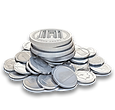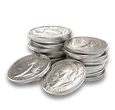How to Calculate a Coin’s Premium Over Spot (Updated for 2025)-A Complete Guide for Gold, Silver, and Platinum Investors
- GoldsilverJapan

- Sep 5
- 4 min read
Whether you’re stacking silver rounds, investing in gold bullion, or evaluating a new platinum coin, understanding the premium over spot price is absolutely critical. This guide will walk you through what a premium is, how to calculate it, and how to use it to make smarter purchases—using real 2025 spot prices.
We'll answer common questions like:
“What is a coin’s premium over spot?”
“How do I calculate it myself?”
“What’s a fair premium in 2025?”
“How can I avoid overpaying?”
Let’s break it all down—clearly, practically, and with examples.
🪙 What is the “Spot Price”?
The spot price is the current price per ounce of a precious metal on global commodities markets. It fluctuates in real time based on:
Market demand
Economic indicators
Inflation fears
Currency values
Geopolitical risks
🟡 Gold (2025): $3,500/oz⚪ Silver (2025): $42/oz🔵 Platinum (2025): $1,500/oz⚫ Palladium (2025): $1,350/oz
The spot price reflects raw metal value, not the finished product price.
💵 What Is a Coin Premium?
A premium is the markup you pay above spot. It covers:
Refining and minting costs
Dealer markup
Packaging and shipping
Supply and demand dynamics
Collectibility (if applicable)
🔎 Premium = Coin price – Spot value of the metal
You can express it in a dollar amount or as a percentage:
Premium (%) = [(Price – Spot Value) ÷ Spot Value] × 100
📊 Real Examples Using 2025 Spot Prices
Example 1: 1 oz Silver American Eagle
Spot price: $42
Retail price: $52
Premium = $52 - $42 = $10Premium (%) = ($10 ÷ $42) × 100 = 23.8%
Example 2: 1 oz Gold Maple Leaf
Spot price: $3,500
Retail price: $3,720
Premium = $220Premium (%) = (220 ÷ 3,500) × 100 = 6.29%
Example 3: 1 oz Platinum Coin
Spot price: $1,500
Retail price: $1,610
Premium = $110Premium (%) = 7.3%
Example 4: 10 oz Silver Bar
Spot price: $42
Total metal value: 10 oz × $42 = $420
Price paid: $450
Premium = $30Premium (%) = (30 ÷ 420) × 100 = 7.14%
➡️ The larger the product, the lower the premium per ounce (usually).
🔄 Why Premiums Vary
Premiums can vary widely depending on:
📉 How to Lower Your Premium
Here are 6 proven ways to reduce your cost:
✅ 1. Buy in Bulk
Buying 10 oz or 100 oz silver bars lowers the premium significantly.
Example:1 oz Silver Coin premium = ~23%100 oz Bar premium = ~2%
⚠️ But: Larger bars are harder to sell quickly and offer less flexibility.
✅ 2. Avoid Semi-Numismatics for Stacking
Semi-numismatics are limited-edition or themed coins like:
Disney coins
James Bond coins
Star Wars/Marvel rounds
These can carry premiums of 40–100%, but resale value is unpredictable. They're for collectors, not for stackers.
💬 If your goal is metal accumulation, avoid these.
✅ 3. Stick with Recognized Bullion
Coins like:
Silver Eagles
Gold Maples
Britannias
Kangaroos
Have lower spreads and are easier to sell, even at slightly higher premiums.
✅ 4. Shop Around
Compare at least 3 dealers. Look for:
Tiered pricing
Volume discounts
Shipping included
Honest, upfront fees
✅ 5. Check Seller Ratings on Marketplaces
If you're buying from eBay, Yahoo Auctions, or Mercari:
Stick to “Top Rated” or well-reviewed sellers
Avoid new accounts or vague descriptions
Don’t fall for prices way below spot—it’s probably fake
✅ 6. Use Price Tracking Tools
Track live spot prices with sites like:
Kitco
BullionVault
APMEX
JM Bullion
Some even show historical premiums for popular products.
🤯 What About Junk Silver?
“Junk” silver refers to pre-1965 coins that contain real silver, but have no collectible value. They're a great stacking option with low premiums.
💴 Japanese Junk Silver
50 Sen
20 Sen
10 Sen➡️ Usually 72%–80% silver depending on the year
🇨🇦 Canadian Junk Silver
Quarters, dimes, and halves minted before 1967➡️ Contain 80% silver
📉 Premiums often range 5–10%, cheaper than bullion coins.
❌ What NOT to Do
Don’t buy proof or reverse-proof coins unless you’re a collector
Don’t assume higher premium = better quality
Don’t forget to calculate spot value before buying
🧠 Frequently Asked Questions (FAQ)
Q: What is a “good premium” for silver in 2025?
Under 10% = great
10–15% = okay
Over 20% = only if the coin is highly liquid (like Eagles)
Q: Should I care about premiums when selling?
Yes! You won’t get the premium back unless:
The coin is in high demand
It’s a limited edition with collector value
You're selling to a retail buyer, not a dealer
Q: What about graded coins (slabbed)?
Graded bullion coins like PCGS MS70 may carry huge premiums, but they’re harder to sell. For stacking, avoid them unless you understand the market.
Q: What is the lowest premium item I can buy?
Usually:
100 oz silver bars
1 oz gold bars
Junk silver in bulk
🧭 Final Thoughts: Stack Smart, Not Just Hard
Understanding how to calculate and manage coin premiums is essential for every serious metal buyer.
📌 Key Takeaways:
Always compare coin price to spot value
Calculate the percentage premium
Know your goal: stacking vs collecting
Avoid high-premium coins unless you’re a collector
Use larger bars or junk silver to lower cost per ounce
💬 Your first few purchases matter. If you overpay or get scammed, it can kill your motivation. Stick with known dealers and double-check every calculation.
👉 Need help calculating your coin's premium? Just ask—I can walk you through it, or help you analyze any listing.











Comments